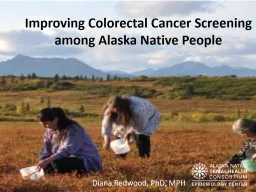

Diana Redwood PhD MPH Why is CRC Screening Important Photo Source wwwmedicalinfoy3nblogspotcom 3 More than 95 of Colorectal Cancers Follow AdenomaCarcinoma Sequence Normal Colon Colon Cancer ID: 908217
Download Presentation The PPT/PDF document "Improving Colorectal Cancer Screening am..." is the property of its rightful owner. Permission is granted to download and print the materials on this web site for personal, non-commercial use only, and to display it on your personal computer provided you do not modify the materials and that you retain all copyright notices contained in the materials. By downloading content from our website, you accept the terms of this agreement.
Slide1
Improving Colorectal Cancer Screening among Alaska Native People
Diana Redwood, PhD, MPH
Slide2Why is CRC Screening Important?
Slide3Photo
Source: www.medicalinfo-y3n.blogspot.com
3
Slide4More than 95% of Colorectal Cancers Follow Adenoma-Carcinoma Sequence
Normal Colon
Colon Cancer
Polyp
Slide5Colon Cancer
Slide6Five-Year Survival Rates (%)
Data Source: American Cancer Society.
Colorectal Cancer Facts & Figures 2017-2019
.
Stage
I and II
Stage
III
Stage IV
Slide7Slide8Colorectal Cancer: Alaska
The 4th
most commonly diagnosed cancer (2
nd for Alaska Native people)The 2nd most common cause of cancer death
Lung cancer is first
Alaska Native People incidence and mortality rates are twice the rates for
whites- and incidence and mortality rates not declining
Slide9Risk Factors
Non-modifiable:
Age, family history
Slide10Risk Factors
Modifiable:
Physical
inactivity, obesity, high consumption of red or processed
meats,
low consumption of fruits and vegetables, alcohol
use, tobacco use
Slide11Possible signs of CRCBlood in stool Diarrhea or constipation that lasts for more than a few days
Frequent gas pains or bloatingAlways tiredLosing weight for no reason
Slide12Colon cancer often starts quietly, with no signs or symptoms.
Slide13SCREENING SAVES LIVES
13
Slide14Alaska Native people: 71.1% Alaska non-Native people: 65.6%
Slide15USPSTF Recommendations for Average Risk Adults Ages 50-75
Starting at age 50 (ANMC guidelines: age 40 for Alaska Native people)…Annual screening with high-sensitivity FOBT
Sigmoidoscopy every 5 years, with high-sensitivity FOBT every 3 yearsScreening colonoscopy every 10
years
Slide16Persons at increased risk due to family or personal history should be screened with colonoscopy and at an earlier age than the general population.
16
Slide17CRC screening guidelines:Family history
CRC in a first-degree relative (parent, sibling, children) or multiple second-degree relatives (grandparent, grandchild, uncle, aunt, nephew, niece):Colonoscopy every
five years starting at age 40 or
ten years before the youngest case in the immediate family.
17
Slide18Screening Test Pros and Cons: FIT
Quick to useNo dietary and medication restrictions
Minimally invasive
Inexpensive ($5-20)Doesn’t require trained personnel for administration
Annual administration
Need to follow up positive results with colonoscopy
Slide19Only required every
5-10 yearsCan detect and remove precancerous growths
More
invasive and more
risk of complications
Resource intensive
Not available throughout Alaska
Not all patients will do
Screening Test Pros
and Cons: Colonoscopy
Slide20Which test is best?
Slide21The one that gets done!
Slide22Why don’t people get screened?
Slide23Personal factors
Fear
Discomfort/unpleasant procedure
Feel healthy/don’t know it’s important
Don’t want to travel/too expensive
Too busy
Slide24System factors
Screening not available in community
No tracking system for screening
Provider didn’t know patient was due
No strong recommendation from provider
Slide25Screening Completion
Cancer Screening Continuum
Slide2676%
of CRC deaths occurred in people who were not up to date with screening
Source:
Doubeni et al. Gastroenterology
2019.
Slide27COVID-19 and CRC screening
Source: IQVIA Institute
: Shifts in healthcare demand, delivery and care during the COVID-19 era
. IQVIA Institute for Human Data Science. April 2020.
Slide28What’s happening with CRC screening now?Postponed
Patient FearReduced Capacity
Source: American Cancer Society. Cancer screening during the COVID-19 pandemic. www.cancer.org
.
Slide292020-2025
Slide30Evidence-based interventions (EBIs)
for CRC screening
Slide31Systems
& EHR Changes
31
Slide32CRC Screening Patient Navigators & First
Degree Relative
Outreach
Slide33Slide34Slide35Photo courtesy of
Norton Sound Health Corporation
*Redwood et al.
Prev
Chronic Dis
2013; 10:E40
Slide36Alaska
Native CRC
Research
Studies
Slide37Slide38How can
providers
help?
Photo courtesy of ANTHC Comprehensive Cancer Program
Use
CRC screening
resources with your patients
Talk to
patients,
friends and family about
the importance
of screening
Get
screened if
you are
due
Slide39Slide40Slide41CRC incidence by age at diagnosis among Alaska Native people compared to US White people, 2014-2018